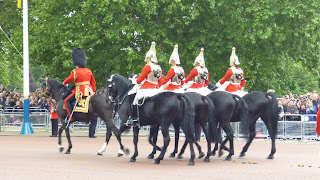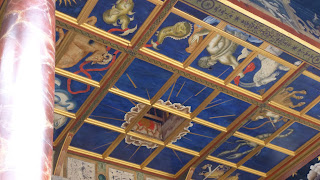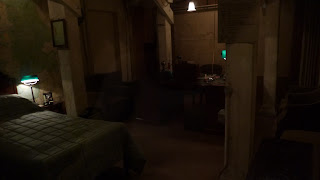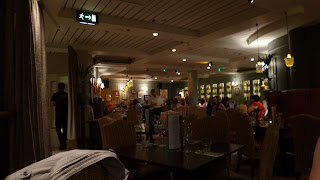Our first full day in London dawned and after a good breakfast we made our way to the station to catch the tube for our first visit of the day, The Globe Theatre, Bankside, Southwark, on the south bank of the Thames. We crossed the Millenium Footbridge across the Thames to get to the theatre. Here I am on the bridge with St. Paul's in the background.
This was our first glimpse of the theatre as we crossed the Millenium Footbridge.
The
Globe Theatre was a theatre in London associated with William Shakespeare. It was built in 1599 by Shakespeare's playing company and was destroyed by fire on 29 June 1613.
A second Globe Theatre was built on the same site by June 1614 and closed in 1642.
A modern reconstruction of the Globe, named Shakespear's Globe, opened in 1997 approximately 750 feet (230 m) from the site of the original theatre.
The new Globe owes its rise to Sam Wanamaker who founded the Shakespeare Globe Trust to rebuild the Globe in London, and he played a central role in realizing the project,
eventually raising well over ten million dollars. Sam, on his first visit to London in 1949 had sought traces of the original theatre and a was astonished to find only a
blackened plaque on an unused brewery. He found this neglect
inexplicable, and in 1970 launched the Shakespeare Globe Trust, later
obtaining the building site and necessary permissions despite a hostile
local council. He syphoned his earnings as actor and director into the
project, undismayed by the scepticism of his British colleagues.
On the south bank of the River Thames, near where the modern recreation of Shakespeare's Globe
stands today, is a plaque that reads: "In Thanksgiving for Sam
Wanamaker, Actor, Director, Producer, 1919–1993, whose vision rebuilt
Shakespeare's Globe Theatre on Bankside in this parish".
For his work in reconstructing the Globe Theatre, Wanamaker, in July of 1993, was made an honorary Commander of the Order of the British Empire
(CBE). He was also honoured with the Benjamin Franklin Medal by the Royal Society of Arts
in recognition of his contribution to theatre.
The Theatre is amazing inside, faithfully reproduced, as far as it can be, to the original. Here are some photos, which really don't do it justice I have to say.
After a fabulous tour of the theatre we walked along Bankside taking in the sights. Here's London Bridge with St Paul's in the background.
We walked a little further and came to The Anchor pub, where we had lunch. You can see
The Shard, the tallest building in Western Europe, in the background.
After lunch we walked a little further and came across The Clink Prison Museum, built on the original site of the Clink Prison. The Prison dates back to 1144, making it one of England's oldest, if not the oldest prison.
The Clink Prison was used to control the Southbank of London known as "The Liberty of The Clink". This area housed much of London's entertainment establishments including four theatres, bull-baiting, bear-baiting, inns and many other darker entertainments. We didn't go in as we had other places to go.
We headed back to the Millenium footbridge and St. Paul's,
and onto
Churchill'sWar Rooms, underneath the Cabinet Offices on King Charles Street, to see the wartime bunker that sheltered Churchill and his government during the Blitz. Construction of the Cabinet War Rooms began in 1938. They became operational in August 1939, shortly before the outbreak of war in Europe. They remained in operation throughout the Second World War, before being abandoned in August 1945 after the surrender of Japan. After the war the historic value of the Cabinet War Rooms was recognised. Their preservation became the responsibility of the Ministry of Works and later the Department for the Environment,
during which time very limited numbers of the public were able to visit
by appointment. In the early 1980s the Imperial War Museum was asked to
take over the administration of the site, and the Cabinet War Rooms
were opened to the public in April 1984. The museum was reopened in 2005
following a major redevelopment, as the Churchill Museum and Cabinet
War Rooms but in 2010 this was shortened to the Churchill War Rooms.
The next photo is of Churchill's bedroom in the War Rooms.
It was a fascinating tour, the whole place is huge with so many rooms dedicated to different aspects of the defence of our country. When operational, the facility's Map Room was in constant use and manned
around the clock by officers of the Royal Navy, British Army and Royal
Air Force. These officers were responsible for producing a daily
intelligence summary for the King, Prime Minister and the military
Chiefs of Staff.
Our next stop was The British Museum to see the new exhibition,
Life & Death Pompeii and Herculaneum, but as our slot wasn't until 4.20p.m. we had a bit of time to kill. The sun was shining and we were thirsty so guess what we did?
Yep, we sat outside a pub opposite the museum and enjoyed a pint of real ale, what else? Before long it was time to go over to the Museum. The Exhibition is very popular but the tours are evenly spaced so it wasn't too cramped inside. Once inside there is a short film explaining what the artefacts on show represent.
AD 79. In just 24 hours, two cities in the Bay
of Naples in southern Italy were buried by a catastrophic eruption
of Mount Vesuvius. Preserved under ash, the cities lay buried for just over 1,600
years, their rediscovery providing an unparalleled glimpse into the
daily life of the Roman Empire.
From the bustling street to the intimate spaces of a Roman home,
this major exhibition takes you to the heart of people’s lives
in Pompeii and Herculaneum.
Photography was not allowed in the exhibition so I have no pictures to share with you, but if you follow the link
here you can see what the Museum says about it.
After the exhibition we made our way to Covent Garden to a restaurant recommended by
Morning AJ,
Dishoom, a Bombay Cafe, where we enjoyed a lovely meal before catching the tube back to Bayswater and our hotel, to rest our weary bones after a hard day sightseeing, in preparation for more the following day.
Join me next time for more sightseeing in London 2013 Part3.

























































